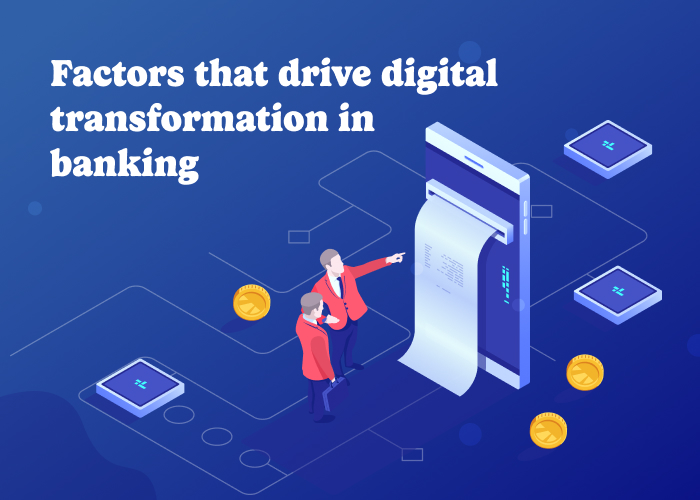Factors that drive digital transformation in banking

The trend of digital transformation, which brings finance to consumers’ hands, is primarily driven by rising smart device usage, increasing connectivity, and a desire for a good end-user experience.
- Why would banks move to online channels? Since their clientele is located there. The digital strategy focuses on meeting the demands and expectations of its clientele. With technology, banks are increasingly providing individualized product experiences, smooth query disintegration, transparency, and security as the cornerstones of client happiness. To put it briefly, the shift has made it necessary to take a “customer approach,” which offers the highest level of interaction.
- As was already said, accomplishing digital transformation involves more than merely putting new technology into use. These days, the underlying infrastructure that makes data accessible to front-end operations has improved the digital transformation of financial services. Modernizing the legacy infrastructure has therefore been the main driver of the banking industry’s digital transition.
- Increased focus on data protection and privacy, such as GDPR, has driven banks to enhance their cybersecurity measures and ensure compliance.
- Leveraging data analytics and AI enables banks to gain insights into customer behavior, enhance risk management, and make data-driven decisions for improved business outcomes.
- The COVID-19 pandemic has accelerated the adoption of digital banking as customers and institutions seek contactless and remote alternatives.
Benefits of using AI for digital transformation in banking
The integration of AI in the banking sector has proven to be a game-changer, driving significant advancements in digital transformation. Here are several key benefits of using AI for digital transformation in banking:
Enhanced Customer Experience
AI-powered chatbots and virtual assistants provide immediate and personalized customer support, addressing queries, and guiding users through various banking processes, leading to a seamless and enhanced customer experience.
Personalized Services
AI algorithms analyze customer data to understand individual preferences and behaviors. This enables banks to offer personalized product recommendations, such as tailored financial plans, investment options, and loan offerings, fostering stronger customer relationships.
Fraud Detection and Prevention
AI algorithms excel in detecting unusual patterns and anomalies in transaction data. Banks can leverage AI to enhance security measures, identify potential fraudulent activities in real time, and implement proactive measures to prevent financial losses.
Risk Management
AI-based predictive analytics models analyze historical data to assess credit risks more accurately. This assists banks in making informed lending decisions, optimizing loan approval processes, and minimizing default risks.
Automation of Routine Tasks
AI automates repetitive and time-consuming tasks, such as data entry, document verification, and routine customer inquiries. This allows bank employees to focus on more complex and strategic aspects of their roles, increasing overall operational efficiency.
Improved Decision-Making
AI systems analyze vast amounts of data to generate actionable insights for better decision-making. This helps banks identify market trends, customer preferences, and potential areas for business growth, contributing to more informed strategic planning.
Investment Management
AI algorithms enable automated trading strategies and investment management by analyzing market trends, predicting price movements, and executing trades at high speeds. This enhances the efficiency of financial institutions in managing investments and optimizing returns.
Operational Efficiency
Automation through AI reduces operational costs by streamlining processes, minimizing errors, and decreasing the need for manual intervention. This allows banks to allocate resources more efficiently and focus on strategic initiatives.
Technologies used in modern banking
Following the digital transformation in banking, modern technologies used are as follows:
- IoT: It is incredibly useful for real-time data analysis. Customers may quickly and easily conduct contactless payments with ease thanks to the Internet of Things and its intelligent device connection.
- Blockchain: Increased accuracy, a better user experience, and safe data exchanges are the outcomes of blockchain integration in banking. Customers firmly feel that blockchain technologies have improved the transparency and convenience of transactions and other financial processes.
- Cloud computing: The most widely used technology in the banking and financial industries is cloud computing. Instantaneous product and service delivery, increased productivity, and enhanced operations are the outcomes of cloud-driven services.
- Data analytics: Data analytics solutions have opened up new avenues for banking growth and have quickly adjusted to meet the increasing needs of the industry.
Conclusion
The digital transformation in banking sector is not merely a technological evolution but a strategic imperative that redefines the industry landscape. The advantages of embracing digital transformation in banking are multifaceted, ranging from enhanced customer experiences to improved operational efficiency, risk management, and innovation. As financial institutions continue to leverage technologies like Artificial Intelligence, blockchain, and automation, they position themselves not only to thrive in the digital era but to set new standards for excellence.
FAQs
How does digital transformation improve customer experiences in banking?
What role does digital transformation play in risk management for banks?
How does digital transformation contribute to cost savings in the banking sector?
Can digital transformation help banks stay compliant with evolving regulations?
What impact does digital transformation have on innovation in banking?
Ravi Bhojani is the Chief Marketing Officer (CMO) at Alian Software, where he spearheads the company’s marketing strategies and drives its brand presence in the competitive IT services landscape. With over a decade of experience in the technology and marketing sectors, Ravi has consistently demonstrated his ability to blend innovative marketing techniques with deep industry knowledge to deliver outstanding results.